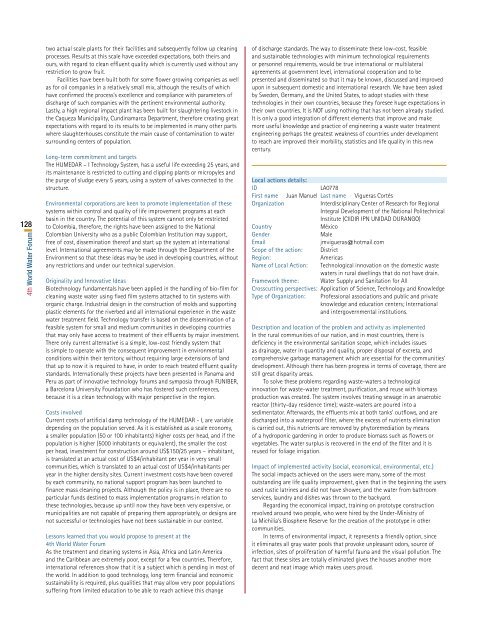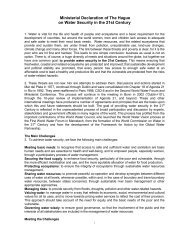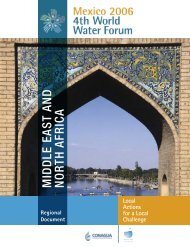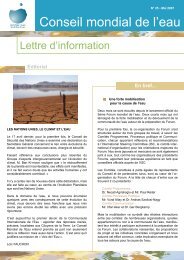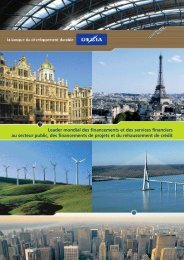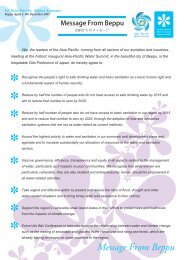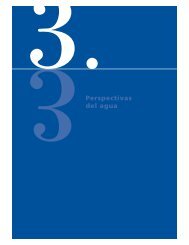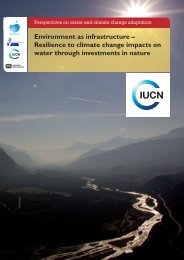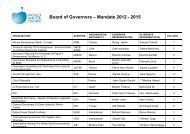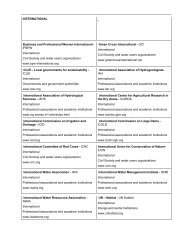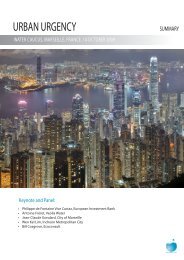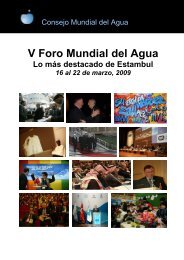Americas ok.indd - World Water Council
Americas ok.indd - World Water Council
Americas ok.indd - World Water Council
Create successful ePaper yourself
Turn your PDF publications into a flip-book with our unique Google optimized e-Paper software.
1284th <strong>World</strong> <strong>Water</strong> Forumtwo actual scale plants for their facilities and subsequently follow up cleaningprocesses. Results at this scale have exceeded expectations, both theirs andours, with regard to clean effluent quality which is currently used without anyrestriction to grow fruit.Facilities have been built both for some flower growing companies as wellas for oil companies in a relatively small mix, although the results of whichhave confirmed the process’s excellence and compliance with parameters ofdischarge of such companies with the pertinent environmental authority.Lastly, a high regional impact plant has been built for slaughtering livestock inthe Caqueza Municipality, Cundinamarca Department, therefore creating greatexpectations with regard to its results to be implemented in many other partswhere slaughterhouses constitute the main cause of contamination to watersurrounding centers of population.Long-term commitment and targetsThe HUMEDAR – I Technology System, has a useful life exceeding 25 years, andits maintenance is restricted to cutting and clipping plants or micropyles andthe purge of sludge every 5 years, using a system of valves connected to thestructure.Environmental corporations are keen to promote implementation of thesesystems within control and quality of life improvement programs at eachbasin in the country. The potential of this system cannot only be restrictedto Colombia, therefore, the rights have been assigned to the NationalColombian University who as a public Colombian Institution may support,free of cost, dissemination thereof and start up the system at internationallevel. International agreements may be made through the Department of theEnvironment so that these ideas may be used in developing countries, withoutany restrictions and under our technical supervision.Originality and Innovative IdeasBiotechnology fundamentals have been applied in the handling of bio-film forcleaning waste water using fixed film systems attached to tin systems withorganic charge. Industrial design in the construction of molds and supportingplastic elements for the riverbed and all international experience in the wastewater treatment field. Technology transfer is based on the dissemination of afeasible system for small and medium communities in developing countriesthat may only have access to treatment of their effluents by major investment.There only current alternative is a simple, low-cost friendly system thatis simple to operate with the consequent improvement in environmentalconditions within their territory, without requiring large extensions of landthat up to now it is required to have, in order to reach treated effluent qualitystandards. Internationally these projects have been presented in Panama andPeru as part of innovative technology forums and symposia through FUNIBER,a Barcelona University Foundation who has fostered such conferences,because it is a clean technology with major perspective in the region.Costs involvedCurrent costs of artificial damp technology of the HUMEDAR - I, are variabledepending on the population served. As it is established as a scale economy,a smaller population (50 or 100 inhabitants) higher costs per head, and if thepopulation is higher (5000 inhabitants or equivalent), the smaller the costper head, investment for construction around US$150/25 years – inhabitant,is translated at an actual cost of US$4/inhabitant per year in very smallcommunities, which is translated to an actual cost of US$4/inhabitants peryear in the higher density sites. Current investment costs have been coveredby each community, no national support program has been launched tofinance mass cleaning projects. Although the policy is in place, there are noparticular funds destined to mass implementation programs in relation tothese technologies, because up until now they have been very expensive, ormunicipalities are not capable of preparing them appropriately, or designs arenot successful or technologies have not been sustainable in our context.Lessons learned that you would propose to present at the4th <strong>World</strong> <strong>Water</strong> ForumAs the treatment and cleaning systems in Asia, Africa and Latin Americaand the Caribbean are extremely poor, except for a few countries. Therefore,international references show that it is a subject which is pending in most ofthe world. In addition to good technology, long term financial and economicsustainability is required, plus qualities that may allow very poor populationssuffering from limited education to be able to reach achieve this changeof discharge standards. The way to disseminate these low-cost, feasibleand sustainable technologies with minimum technological requirementsor personnel requirements, would be true international or multilateralagreements at government level, international cooperation and to bepresented and disseminated so that it may be known, discussed and improvedupon in subsequent domestic and international research. We have been askedby Sweden, Germany, and the United States, to adopt studies with thesetechnologies in their own countries, because they foresee huge expectations intheir own countries. It is NOT using nothing that has not been already studied.It is only a good integration of different elements that improve and makemore useful knowledge and practice of engineering a waste water treatmentengineering perhaps the greatest weakness of countries under developmentto reach are improved their morbility, statistics and life quality in this newcentury.Local actions details:IDLA0778First name Juan Manuel Last name Vigueras CortésOrganizationInterdisciplinary Center of Research for RegionalIntegral Development of the National PolitechnicalInstitute (CIIDIR IPN UNIDAD DURANGO)CountryMéxicoGenderMaleEmailjmvigueras@hotmail.comScope of the action: DistrictRegion:<strong>Americas</strong>Name of Local Action: Technological innovation on the domestic wastewaters in rural dwellings that do not have drain.Framework theme: <strong>Water</strong> Supply and Sanitation for AllCrosscutting perspectives: Application of Science, Technology and KnowledgeType of Organization: Professional associations and public and privateknowledge and education centers; Internationaland intergovernmental institutions.Description and location of the problem and activity as implementedIn the rural communities of our nation, and in most countries, there isdeficiency in the environmental sanitation scope, which includes issuesas drainage, water in quantity and quality, proper disposal of excreta, andcomprehensive garbage management which are essential for the communities’development. Although there has been progress in terms of coverage, there arestill great disparity areas.To solve these problems regarding waste-waters a technologicalinnovation for waste-water treatment, purification, and reuse with biomassproduction was created. The system involves treating sewage in an anaerobicreactor (thirty-day residence time); waste-waters are poured into asedimentator. Afterwards, the effluents mix at both tanks’ outflows, and aredischarged into a waterproof filter, where the excess of nutrients eliminationis carried out, this nutrients are removed by phytoremediation by meansof a hydroponic gardening in order to produce biomass such as flowers orvegetables. The water surplus is recovered in the end of the filter and it isreused for foliage irrigation.Impact of implemented activity (social, economical, environmental, etc.)The social impacts achieved on the users were many, some of the mostoutstanding are life quality improvement, given that in the beginning the usersused rustic latrines and did not have shower, and the water from bathroomservices, laundry and dishes was thrown to the backyard.Regarding the economical impact, training on prototype constructionrevolved around two people, who were hired by the Under-Ministry ofLa Michilía’s Biosphere Reserve for the creation of the prototype in othercommunities.In terms of environmental impact, it represents a friendly option, sinceit eliminates all gray water pools that prov<strong>ok</strong>e unpleasant odors, source ofinfection, sites of proliferation of harmful fauna and the visual pollution. Thefact that these sites are totally eliminated gives the houses another moredecent and neat image which makes users proud.


